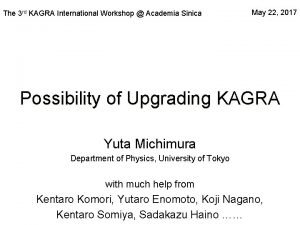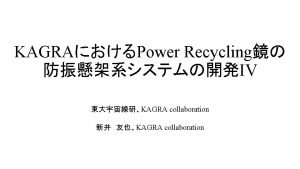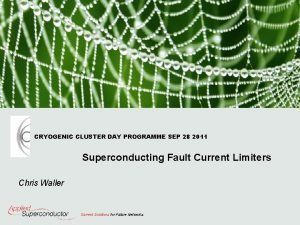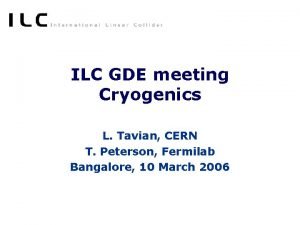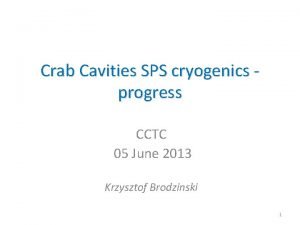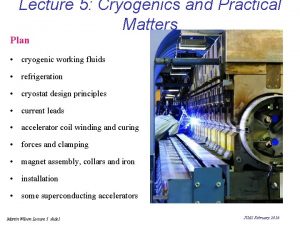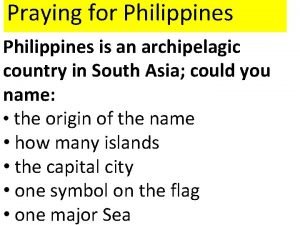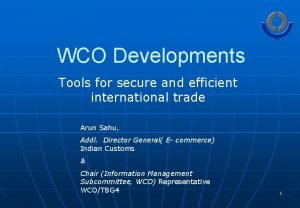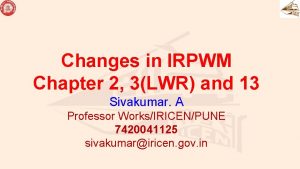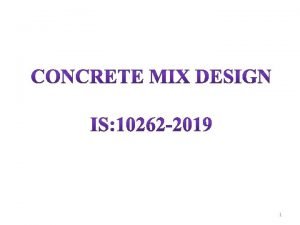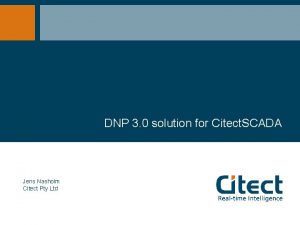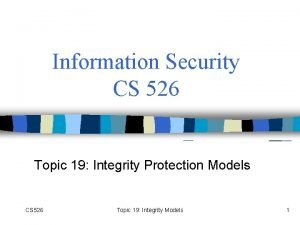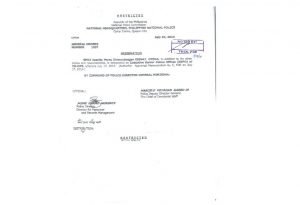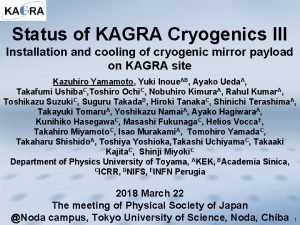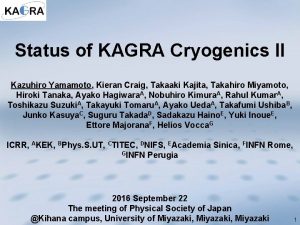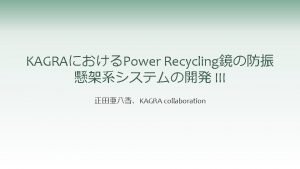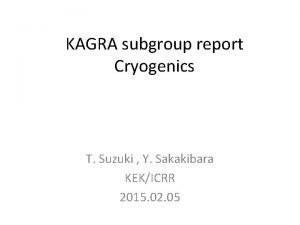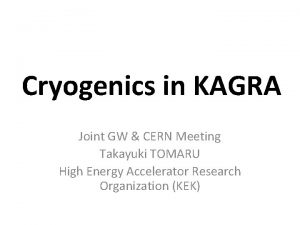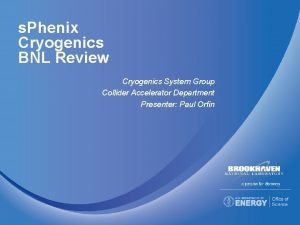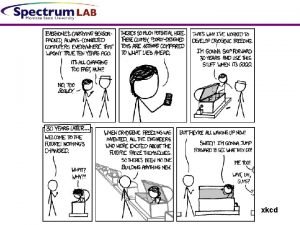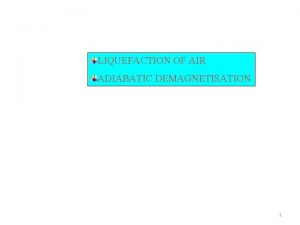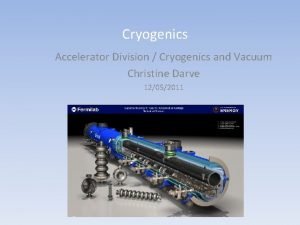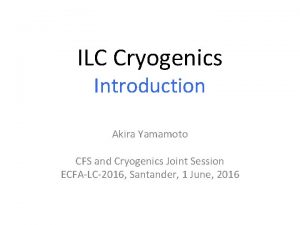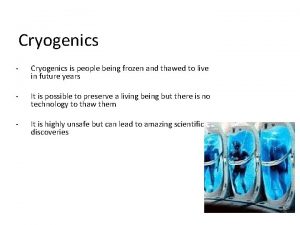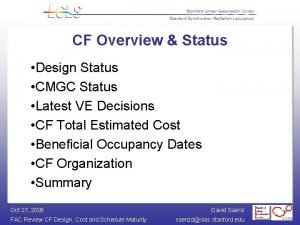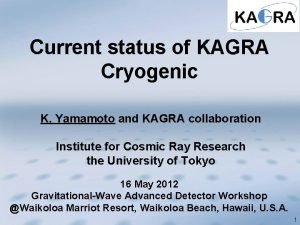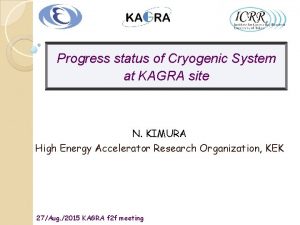The Latest Status of the KAGRA Cryogenics N
















- Slides: 16

The Latest Status of the KAGRA Cryogenics N. KIMURA A, D. CHEN B, T. KUME A, S. KOIKE A, Y. SAKAKIBARA B, T. SUZUKI A, C. TOKOKU B, K. YAMAMOTO B, M. OHASHI B, and K. KURODA B High Energy Accelerator Research Organization, KEK B ICRR, University of Tokyo, A ET-meeting, 22 th Oct. 2013 N. KIMURA/KEK

Appendix ET-meeting, 22 th Oct. 2013 N. KIMURA/KEK Yusuke Sakakibara 2

Thermal Radiation Results Experiment where SMALL plate is heated up to 300 K and BIG plate absorbs radiation was conducted Heat transfer of left and right direction should be equal ◦ Otherwise, even if two plates have same temperature, heat will be transferred ET-meeting, 22 th Oct. 2013 N. KIMURA/KEK Yusuke Sakakibara 3

Design of duct shield Optical lever Length in mm Pipe-shaped thermal radiation shield ◦ Baffles are designed 17 m Not to block out optical lever to sense tilt of mirror To minimize thermal radiation onto mirror ◦ Three sections are cooled down independently by three cryocoolers ◦ Cryocooler for section 2 was not operated ET-meeting, 22 th Oct. 2013 N. KIMURA/KEK Yusuke Sakakibara 4

The interior of the cryostat Drawn by S. KOIKE (KEK) Support rods View Ports Heat path to cryocooler ET-meeting, 22 th Oct. 2013 N. KIMURA/KEK Double radiation shields with hinged doors

Estimated Thermal Budget 80 W by the radiation 94 K at the top of at 80 K outer shield the 80 K outer shield at the top of the 2. 0 W 9 by. Kthe radiation K inner shield at 8 K 8 inner shield 0. 3 W by the with radiation Connection point IM and conduction (support posts and tension rods) at 8 K st cold stage 537. 6 K at W 1 by the radiation and ofconduction Cryo-cooler (support posts and tension rods) at 80 K 7. 1 K at 2 nd cold stage of Cryod. T 1 st = 17 K cooler d. T 2 nd=1. 5 K Very High Purity Aluminum Conductor (5 N 8) Low Vibration Cryo-cooler unit ET-meeting, 22 th Oct. 2013 N. KIMURA/KEK 6

Requirement and Answer Requirements for KAGRA cryogenics Satisfy the requirements for the Cryogenics • • Adopt Pulse Tube-type Cryo-cooler units< 20 [K] Temperature of the test mass/mirror with very low vibration mount Inner radiation shield have to be cooled to < 8 K based on the CLIO type cooler. The test mass be cooled • • Adopt f 2200 of have innerto diameter of without flanges introducing for installation of the mirror and excess noise, work especially vibration duesuspension. to cryocoolers. • Analyzed the cryostat response to • ground Easy access capacity motionand at enough Kamioka-mine. • Heat load from components lowmirror. as possible. to installation work aroundas the • Develop very low out gas super insulation system for • Allowable size as large as possible under public radiative heat load but also useable transport regulation and KAGRA tunnel. under ultra high vacuum < 10 -7 Pa • Satisfy ultra high vacuum specification < 10 -7 Pa ET-meeting, 22 th Oct. 2013 N. KIMURA/KEK

Low Vibration Cryo-cooler Unit Cooling Power ・> 2. 5 W@9 K ( at connection point of 8 K conduction bar) ・> 35 W@70 K ( at connection point of 80 K conduction bar) Photo: Performance test at ICRR Base on CLIO type Cryo-cooler with low vibration mount for KAGRA but cooling power is lager than CLIO ET-meeting, 22 th Oct. 2013 N. KIMURA/KEK Vibration Characteristics ・< ± 100 nm ( at connection point of 8 K conduction bar) ・< ± 100 nm ( at connection point of 80 K conduction bar)

Structure view of the Low Vibration Cryo-cooler Unit Bellows バルブ台 Flexible Heat Links Valve Unit 1 m Part of Vibration Reduction Stage 5 N 8 8 K Conduction Bar 80 K Cooling passage Support Frame (Support: Cold Head) 2 m ET-meeting, 22 th Oct. 2013 N. KIMURA/KEK Vacuum Vessel (Support: Conduction Paths)

Performance of the low vibration cryo-cooler unit Vibration at the connection point To suppress the vibration at 1. 7 Hz below 0. 1 μm/Hz^0. 5, we improved on the support structure design. We measured the vibration of sixteen cryocooler units. We confirmed its vibration reduction ratio lager than 100 and less than 0. 1 μm/Hz^0. 5. Cooling powers of 2. 5 W@9 K and 35 W@70 K were also confirmed too. Impulse response of unit 14 ET-meeting, 22 th Oct. 2013 N. KIMURA/KEK Courtesy by Dr. C. TOKOKU Presented at CEC/ICMC 2013, 2 EPo. E 1 -03, Anchorage, USA (2013).

Cooling Scheme of the mirror Heat transferred via pure aluminum heat links. We need Φ 1 mm, L=1 m heat links x 7~8 Thermal simulation Done by Y. Sakakibara 2012/5/15 ET-meeting, 22 th Oct. 2013 N. KIMURA/KEK GWADW 2012 11

Cooling Time Reduction with DLC To increase cool down by radiation, form black coating with Diamond Like Carbon on outer surface of the payload and inner surface of 8 K shield. Items Materials Mass Platform RM for IM IM TM RM TM : Test Mass RM : Recoil Mass IM : Intermediate Mass S. Koike 12

Half Size Dummy Cryo-payload Experiment with KAGRA cryostats 1/2 size dummy payload was suspended inside cryostat No. 3 Thermal radiation was examined (without any heat links) ◦ Cooling from room temperature Spare of CLIO mirror Model Payloads designed and made by R. Kobayashi, S. Koike (KEK) ET-meeting, 22 th Oct. 2013 N. KIMURA/KEK 2013. 6. 24 CEC/ICMC (Anchorage, Alaska) Yusuke Sakakibara 13

Results • Effect of High Emissivity Coating for Cooling Time of the Payload is Confirmed. Consistent with calculation! Emissivity Sapphire: 0. 5 Platform: 0. 3*(T/300 K) IM: 0. 4*(T/300 K) ET-meeting, 22 th Oct. 2013 N. KIMURA/KEK 2013. 6. 24 CEC/ICMC (Anchorage, Alaska) Yusuke Sakakibara 14

Cooling test in Toshiba Heat Load Response Test Heater and thermometer Pulse tube cryocoolers Sapphire mirror Pulse tube cryocoolers 15

Cooling test in Toshiba Result of Heat Load Response @ 8 K Radiation Shield Mirror Operation 5 W ~ 12. 5 ppm 10 W ~25 ppm 2 W~ 5 ppm 0 W ~0 ppm It is confirmed that 25 ppm (10 W) @400 k. W of scattered loss is acceptable as heat load for the cryocoolers via the 8 K radiation shield. Scatted light power is 4 W @400 k. W beam power when scattered loss on the mirror surface is 10 ppm. 16
 Kagra international workshop
Kagra international workshop Kagra
Kagra Cryogenics palm harbor
Cryogenics palm harbor Acd cryogenics
Acd cryogenics Kirk welding supply
Kirk welding supply Sps cryogenics
Sps cryogenics Katherine is very interested in cryogenics
Katherine is very interested in cryogenics Practical cryogenics
Practical cryogenics How to show toolbar in word 2016
How to show toolbar in word 2016 Prayer points for philippines
Prayer points for philippines Wco data model latest version
Wco data model latest version Rdso/t-4088 to 4097
Rdso/t-4088 to 4097 Is code 10262 latest revision
Is code 10262 latest revision Citect pty ltd
Citect pty ltd Andrew heywood comparative politics
Andrew heywood comparative politics Latest subject is integrity
Latest subject is integrity Illustrate the organizational structure of the pnp
Illustrate the organizational structure of the pnp
